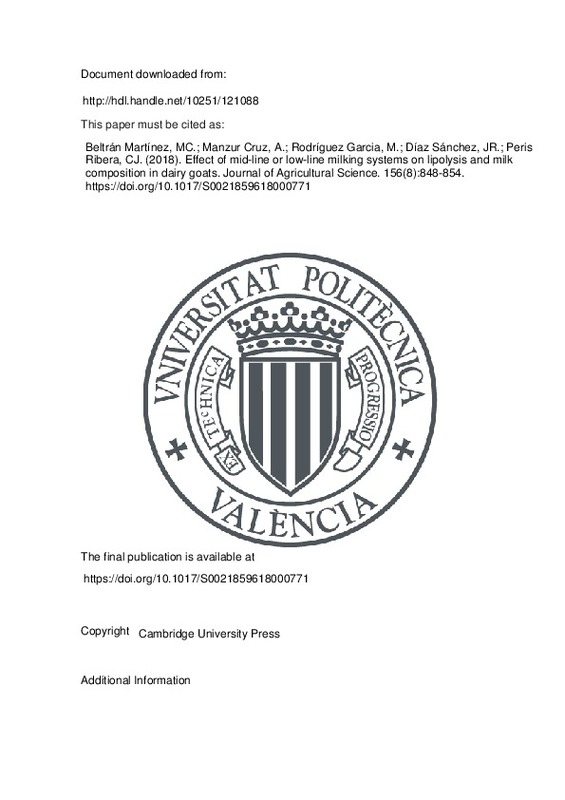JavaScript is disabled for your browser. Some features of this site may not work without it.
Buscar en RiuNet
Listar
Mi cuenta
Estadísticas
Ayuda RiuNet
Admin. UPV
Effect of mid-line or low-line milking systems on lipolysis and milk composition in dairy goats
Mostrar el registro sencillo del ítem
Ficheros en el ítem
| dc.contributor.author | Beltrán Martínez, Mª Carmen
|
es_ES |
| dc.contributor.author | Manzur Cruz, Alberto
|
es_ES |
| dc.contributor.author | Rodríguez Garcia, Martín
|
es_ES |
| dc.contributor.author | Díaz Sánchez, José Ramón
|
es_ES |
| dc.contributor.author | Peris Ribera, Cristófol Josep
|
es_ES |
| dc.date.accessioned | 2019-05-25T20:39:32Z | |
| dc.date.available | 2019-05-25T20:39:32Z | |
| dc.date.issued | 2018 | es_ES |
| dc.identifier.issn | 0021-8596 | es_ES |
| dc.identifier.uri | http://hdl.handle.net/10251/121088 | |
| dc.description.abstract | [EN] Two experiments were carried out to investigate how milking in mid-line (ML) affects the lipolysis level and milk composition in goat livestock, in comparison with low-line (LL) milking. The first experiment took place, in triplicate, on an experimental farm. For each replicate, a crossover design (62 goats, two treatments, ML and LL, in two periods each lasting 4 days) was used. Milk samples were taken daily at 0 and 24 h after milking. In the first experimental replicate, some enzymatic coagulation cheeses were made, which were assessed by a panel of tasters at 50 and 100 days of maturation. In the second experiment, the lipolysis level and composition of tank milk from 55 commercial dairy goat farms (25 ML and 30 LL) were analysed, in milk samples taken in three different weeks. The results of the first experiment showed that ML milking increased free fatty acid (FFA) concentration in raw goat's milk significantly (0.71 v. 0.40 mmol/l, respectively). However, in the milk samples taken from commercial farms the FFA concentration remained unaffected by the milking pipeline height (0.59 v. 0.58 mmol/l for ML and LL, respectively). No significant differences were found in the milk composition, nor in the sensory characteristics in the cured cheeses, which suggests that factors other than the milkline height are able to influence the level of lipolysis under commercial conditions. Therefore, ML milking should not be discouraged, provided that the correct functioning and management of the milking operation and milk storage on the farm is guaranteed. | es_ES |
| dc.language | Inglés | es_ES |
| dc.publisher | Cambridge University Press | es_ES |
| dc.relation.ispartof | Journal of Agricultural Science | es_ES |
| dc.rights | Reserva de todos los derechos | es_ES |
| dc.subject | Goat milk | es_ES |
| dc.subject | Lipolysis | es_ES |
| dc.subject | Milking system | es_ES |
| dc.subject | Mid-line milking | es_ES |
| dc.subject | Low-line milking | es_ES |
| dc.subject.classification | PRODUCCION ANIMAL | es_ES |
| dc.title | Effect of mid-line or low-line milking systems on lipolysis and milk composition in dairy goats | es_ES |
| dc.type | Artículo | es_ES |
| dc.identifier.doi | 10.1017/S0021859618000771 | es_ES |
| dc.rights.accessRights | Abierto | es_ES |
| dc.contributor.affiliation | Universitat Politècnica de València. Departamento de Ciencia Animal - Departament de Ciència Animal | es_ES |
| dc.description.bibliographicCitation | Beltrán Martínez, MC.; Manzur Cruz, A.; Rodríguez Garcia, M.; Díaz Sánchez, JR.; Peris Ribera, CJ. (2018). Effect of mid-line or low-line milking systems on lipolysis and milk composition in dairy goats. Journal of Agricultural Science. 156(8):848-854. https://doi.org/10.1017/S0021859618000771 | es_ES |
| dc.description.accrualMethod | S | es_ES |
| dc.relation.publisherversion | https://doi.org/10.1017/S0021859618000771 | es_ES |
| dc.description.upvformatpinicio | 848 | es_ES |
| dc.description.upvformatpfin | 854 | es_ES |
| dc.type.version | info:eu-repo/semantics/publishedVersion | es_ES |
| dc.description.volume | 156 | es_ES |
| dc.description.issue | 8 | es_ES |
| dc.relation.pasarela | S\382830 | es_ES |







![[Cerrado]](/themes/UPV/images/candado.png)

